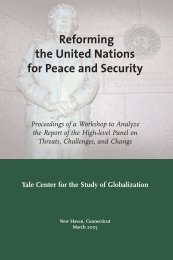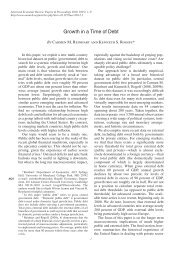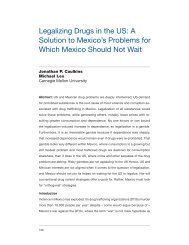The collapse of global trade, murky protectionism, and the crisis:
The collapse of global trade, murky protectionism, and the crisis:
The collapse of global trade, murky protectionism, and the crisis:
You also want an ePaper? Increase the reach of your titles
YUMPU automatically turns print PDFs into web optimized ePapers that Google loves.
10. Trade protection: incipient but worrisome<br />
trends<br />
Elisa Gamberoni <strong>and</strong> Richard Newfarmer<br />
Graduate Institute, Geneva; World Bank<br />
With <strong>the</strong> <strong>global</strong> economy teetering on <strong>the</strong> abyss <strong>of</strong> severe recession, political pressures<br />
dem<strong>and</strong>ing import protection to protect employment are surfacing with<br />
increasing intensity around <strong>the</strong> world. However, if <strong>the</strong>re is one lesson from <strong>the</strong> experience<br />
<strong>of</strong> <strong>the</strong> 1930s, it is that raising <strong>trade</strong> barriers merely compounds recessionary<br />
forces – <strong>and</strong> risks pushing <strong>the</strong> economy into prolonged contraction.<br />
For this reason, G20 leaders signed a pledge on 15 November 2008, to avoid protectionist<br />
measures. However, since <strong>the</strong>n, several countries, including 17 <strong>of</strong> <strong>the</strong> G20,<br />
have implemented 47 measures whose effect is to restrict <strong>trade</strong> at <strong>the</strong> expense <strong>of</strong> o<strong>the</strong>r<br />
countries. While <strong>the</strong> trend is <strong>of</strong> concern, to date, <strong>the</strong>se measures have probably had<br />
only marginal effects on <strong>trade</strong>. <strong>The</strong> sharp contractions in <strong>trade</strong> volumes evident in<br />
recent months are a consequence <strong>of</strong> <strong>the</strong> <strong>global</strong> recession <strong>and</strong> financial feedbacks<br />
through skyrocketing costs <strong>of</strong> a shrunken pool <strong>of</strong> <strong>trade</strong> finance, not protection.<br />
None<strong>the</strong>less, <strong>the</strong> trend in protection is up <strong>and</strong> <strong>the</strong> full effects <strong>of</strong> <strong>the</strong> recession have<br />
not yet been felt, raising concern.<br />
Several countries have adopted new protectionist measures<br />
Since <strong>the</strong> beginning <strong>of</strong> <strong>the</strong> financial <strong>crisis</strong>, <strong>of</strong>ficials have proposed <strong>and</strong>/or implemented<br />
roughly 78 <strong>trade</strong> measures, according to <strong>the</strong> World Bank's monitoring list <strong>of</strong><br />
<strong>trade</strong> <strong>and</strong> <strong>trade</strong>-related measures. This figure is drawn from <strong>the</strong> World Bank's Trade<br />
Department (PRMTR), which maintains a list <strong>of</strong> proposed, enacted <strong>and</strong>/or rejected<br />
<strong>trade</strong> measures taken from news accounts, <strong>of</strong>ficial reports, <strong>and</strong> o<strong>the</strong>r sources.<br />
Virtually all measures are taken from two sources <strong>and</strong> where possible receive confirmation<br />
with country staff, but may be subject to a small margin <strong>of</strong> error as government<br />
policies at times are opaque <strong>and</strong> subject to change, even reversal. This list does<br />
not include "automatic" increases in agricultural protection, contingent protection<br />
(antidumping), WTO-sanctioned measures to compensate for panel findings against<br />
trading partners <strong>and</strong> financial sector subsidies (discussed in subsequent sections).<br />
More important, this discussion does not attempt to quantify <strong>the</strong> <strong>trade</strong> effect <strong>of</strong> any<br />
particular event <strong>and</strong> <strong>the</strong>reby attach some weight to each action – though obviously<br />
some actions have far greater impact in closing markets than o<strong>the</strong>rs.<br />
Of <strong>the</strong>se 78 new measures, 66 involved <strong>trade</strong> restrictions, <strong>and</strong> 47 <strong>trade</strong>-restricting<br />
measures eventually took effect. <strong>The</strong> <strong>trade</strong> effects <strong>of</strong> <strong>the</strong>se measures are difficult to<br />
evaluate due to <strong>the</strong> prevalence <strong>of</strong> non-tariff barriers, subsidies <strong>and</strong> contingent protection<br />
– a task that never<strong>the</strong>less remains to be done. None<strong>the</strong>less, <strong>the</strong> effects <strong>of</strong> <strong>the</strong>se<br />
measures so far are probably minor relative to size <strong>of</strong> unaffected markets, but <strong>of</strong> considerable<br />
importance for particular exporters shut out <strong>of</strong> protected markets.<br />
Tariff increases comprise only about half <strong>of</strong> <strong>the</strong>se actions. For example, Russia<br />
49





